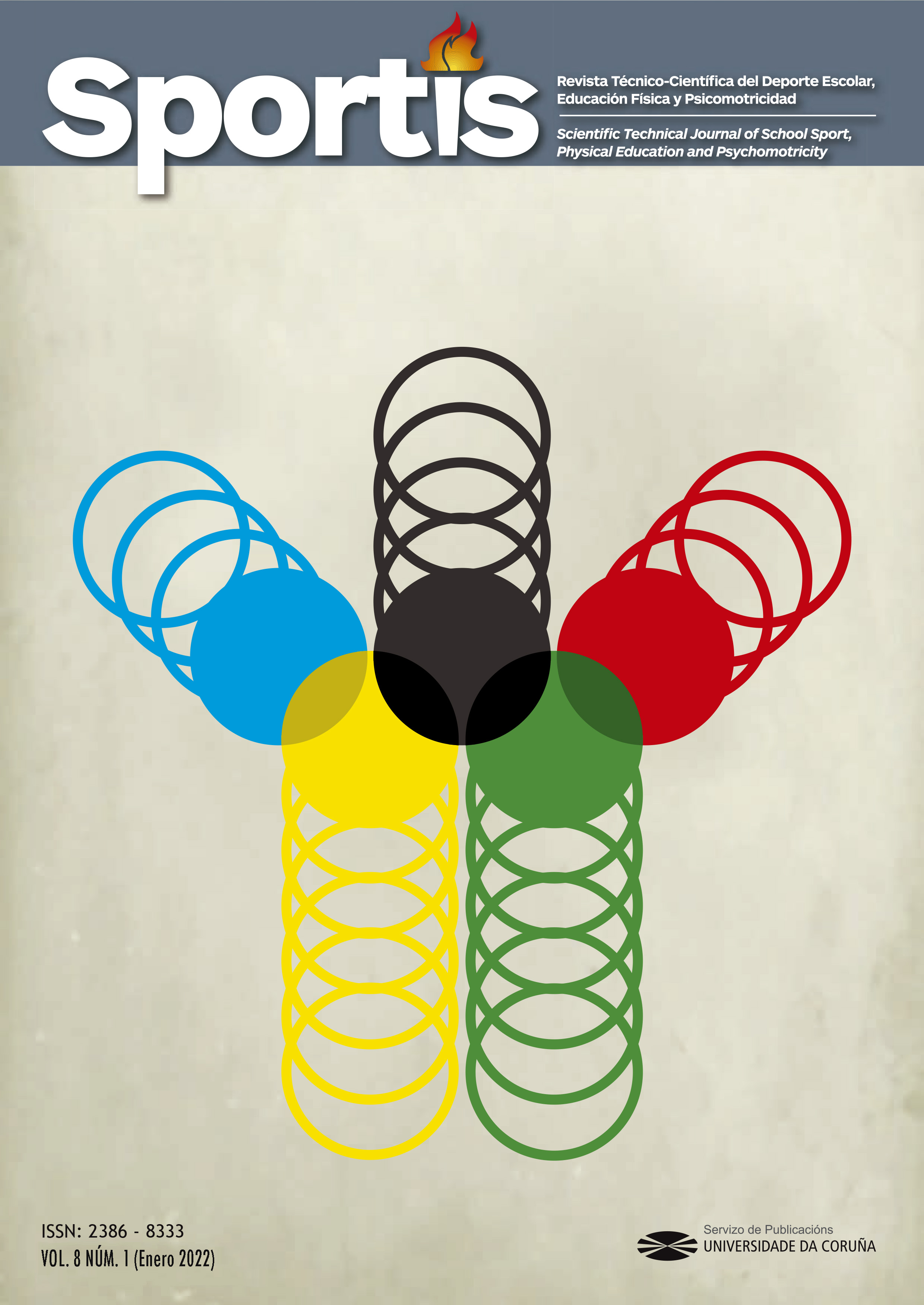Gamification intervention proposal in physical education based on the Harry Potter universe
Main Article Content
Abstract
In the present article, a teaching innovation proposal in the area of Physical Education was elaborated and developed, in which the innovative methodology of gamification was used to work on alternative sports in the first year of secondary education. Gamification is a methodology that manages to improve one of the most important aspects for the students learning, such as motivation. Through this intervention it is intended to offer an educational resource that helps to improve the motivation and involvement of the students in Physical Education classes in accordance with the existing research background on gamification. In this proposal, the alternative sports "Juego de Palas" and "Ultimabola" were worked through a gamified didactic unit based on the Harry Potter universe, with the aim of improving the technical-tactical elements of these sports and showing skills and attitudes of respect, teamwork and sportsmanship. The proposal was methodologically divided into four interconnected parts that include, in turn, the necessary instruments to evaluate the students about the contents worked on, these parts being the individual magical performance, the collective magical performance, the magical attitude and the magical diary. The results indicate that good learning results were obtained as well as a great involvement of the students in both individual and collective performances.
Keywords:
Downloads
Article Details
References
Apostol, S., Zaharescu, L., & Alexe, I. (2013). Gamification of learning and educational games. Paper presented at the International Scientific Conference eLearning and Software for Education, 2, 67-72.
Arufe, V. (2019). Fortnite EF un nuevo juego deportivo para el aula de Educación Física. Propuesta de innovación y gamificación basada en el videojuego Fortnite. Sportis Sci J, 5 (2), 323-350. https://doi.org/10.17979/sportis.2019.5.2.5257
Blázquez, D. (2019). Prólogo. En E. M. Sabastiani, & J. Campo-Rius, Gamificación en Educación Física. Reflexiones y propuestas para sorprender a tu alumnado. (págs. 11-12). Barcelona: Inde.
Cañada, J., Morales, M. E., & Morón, H. (2017). Una comparativa de los modelos de enseñanza: Escuela tradicional vs escuela libre. Sevilla: Universidad de Sevilla.
Deci, E. L., & Ryan, R. M. (1985). Intrinsic Motivation and Self-Determination in Human Behavior. Nueva York: Plenum.
Deterding, S., Khaled, R., Nacke, L. E., & Dixon, D. (2011). Gamification: Toward a definition. Proceedings of the 2011 Workshop Gamification: Using Game Design, Nueva York, NY: ACM.
Dichev, C., & Dicheva, D. (2017). Gamifying education: what is known, what is believed and what remains uncertain: a critical review. International Journal of Educational Technology in Higher Education, 14(9), 1-36. https://doi.org/10.1186/s41239-017-0042-5
Escarvajal, J. C., & Martín-Acosta, F. (2019). Análisis Bibliográfico de la Gamificación en Educación Física. Revista Iberoamericana de Ciencias de la Actividad Física y el Deporte, 8(1), 97-109. https://doi.org/10.24310/riccafd.2019.v8i1.5770
Flores, G. (2019). ¿Jugamos al Súper Mario Bros? Descripción de una experiencia gamificada en la formación del profesorado de Educación Física. Retos, 36, 529-534. https://doi.org/10.47197/retos.v36i36.67816
Huizinga, J. (1984). Homo ludens. Madrid: Alianza.
Instrucción 9/2020, de 15 de junio, de la dirección general de ordenación y evaluación educativa, por la que se establecen aspectos de organización y funcionamiento para los centros que imparten Educación Secundaria Obligatoria. Consejería de Educación y Deporte de la Junta de Andalucía, 171 a 183. Recuperado de https://www.juntadeandalucia.es/educacion/portals/delegate/content/d7eaedd2-f3fd-4781-a9d4-89fae5849481/Instrucci%C3%B3n%209_2020%20de%2015%20de%20junio%20sobre%20incio%20de%20curso%20secundaria%20(%20Anexos%20II_III_IV_V%20Instruccio%C2%BFn%209-2020%20ESO.pdf%20)
Kapp, K. (2012). The Gamification of learning and instruction. San Francisco: Pfeiffer.
León-Díaz, O., Martínez-Muñoz, L. F., & Santos-Pastor, M. L. (2019). Gamificación en Educación Física: Un Análisis Sistemático de Fuentes Documentales. Revista Iberoamericana de Ciencias de la Actividad Física y el Deporte, 8(1), 110-124. https://doi.org/10.24310/riccafd.2019.v8i1.5791
Martínez, G. (1998). El juego y el desarrollo infantil. Barcelona: Octaedro.
Martínez, A., Rodríguez, K., Ochomogo, Y. & Miguelena, R. (2019). Gamificación: La enseñanza divertida. El Tecnológico, 28(1), 9-11.
Monguillot, M., González, C., Zurita, C., Almirall, L. & Guitert, M. (2015). Play the Game: gamificación y hábitos saludables en educación física. Apunts. Educación Física y Deportes, 119, 71-79. http://dx.doi.org/10.5672/apunts.2014-0983.es.%282015/1%29.119.04
Navarro, D., Martínez, R., & Pérez, I. J. (2017). El enigma de las 3 Efes: Fortaleza, fidelidad y felicidad. Revista Española de Educación Física y Deportes, 419, 73-85.
Orden ECD/65/2015, de 21 de enero, por la que se describen las relaciones entre las competencias, los contenidos y los criterios de evaluación de la educación primaria, la educación secundaria obligatoria y el bachillerato. Ministerio de Educación, Cultura y Deporte, de 29 de enero de 2015, 6991 a 7002. Recuperado de https://www.boe.es/boe/dias/2015/01/29/pdfs/BOE-A-2015-738.pdf
Pérez, I., Rivera, E., & Trigueros, C. (2019). 12+1 Sentimientos del Alumnado Universitario de Educación Física frente a una Propuesta de Gamificación: "Game of Thrones: La Ira de los Dragones". Movimento: Revista de Educação Física, 25, 1-15. https://doi.org/10.22456/1982-8918.88031
Prieto, J. M. (2020). Una revisión sistemática sobre Gamificación, Motivación y Aprendizaje en Universitarios. Teoría De La Educación. Revista Interuniversitaria., 32(1), 73-99. https://doi.org/10.14201/teri.20625
Real Decreto 1105/2014, de 26 de diciembre, por el que se establece el currículo básico de la Educación Secundaria Obligatoria y del Bachillerato. Ministerio de Educación, Cultura y Deporte, de 3 de enero de 2015, 176 a 486. Recuperado de https://www.boe.es/boe/dias/2015/01/03/pdfs/BOE-A-2015-37.pdf
Sánchez-Oliva, D., Leo, F. M., Amado, D., González-Ponce, I. & García-Calvo, T. (2012). Desarrollo de un Cuestionario para Valorar la Motivación en Educación Física. Revista Iberoamericana de Psicología del Ejercicio y el Deporte, 7(2), 227-250.
Schulz, T. (2016). ¡Sé creativo! el jefe de innovación de google sabe cómo. Obtenido de https://www.xlsemanal.com/actualidad/20160719/se-creativo-jefe-innovacion-google-sabe.html
Schunk, D. H. (2012). Learning theories. an educational perspective. Boston: Pearson.
Soriano, E., & Osorio, M. (2008). Competencias emocionales del alumnado "autóctono" e inmigrante de educación secundaria. Bordón, 60(1), 129-148.
Vázquez-Ramos, F. J. (2021). Una propuesta para gamificar paso a paso sin olvidar el currículum: modelo Edu-Game. Retos, 39, 811-819. https://doi.org/10.47197/retos.v0i39.76808
Vila, G. (2019). Diferentes velocidades para la introducción de la gamificación en el aula. En E. M. Sebastiani, & J. Campos-Rius, Gamificación en Educación física. Reflexiones y propuestas para sorprender a tu alumnado (pp. 45-50). Barcelona: Inde.







